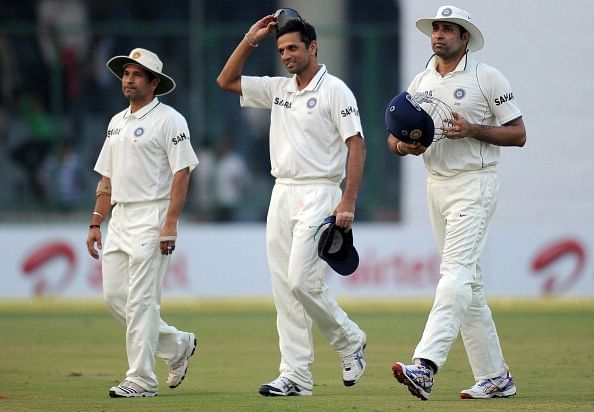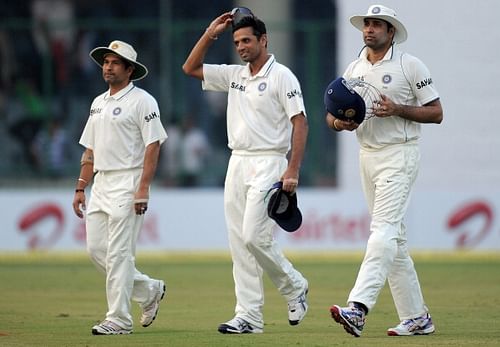
Among alleged successors to the big three, Ajinkya Rahane for VVS Laxman appears the most promising

India are still struggling to fill the void left by the retirement in relatively quick succession of Rahul Dravid, VVS Laxman and Sachin Tendulkar; this has resulted in endless discussions across multiple media channels about the successors to this famed trio. This particular analysis will try to examine how alleged successors of these three are measuring up; the analysis compares statistics, technique and temperament of each pair, taking into account only that many number of matches played by the predecessor which the successor has currently completed.
I am not including Ganguly in the list of predecessors for two reasons; firstly, his retirement came much earlier than either of these three. Secondly, there has not yet emerged a successor, even rumored, for the no. 6 position which Ganguly made his own. Several players like Yuvraj Singh, Suresh Raina, Rohit Sharma, Stuart Binny, etc. have been tried at this position, but till date, none of them have cemented their slot there. This analysis will therefore focus on Cheteshwar Pujara, Ajinkya Rahane, and Virat Kohli, the alleged successors of Dravid, Laxman and Tendulkar, respectively.

Pujara vs Dravid
The Stats: At an overall level, after 23 Test matches, Pujara is slightly ahead in terms of runs and centuries scored, while Dravid has a better average. The view drastically changes when we compare the ‘away’ statistics; after 10 ‘away’ Tests, Dravid’s average is more than twice of Pujara’s, indicating the gulf between the two players when it comes to overseas performances.
Technique: Rahul Dravid, in my opinion, had the finest technique among players I have followed (post 1990 era); his poise at the crease, and the finesse with which he defended or attacked, was a treat to the eyes. His final couple of years of international cricket did expose some chinks in his defence, when he was bowled frequently, but other than this late-life blemish, Dravid’s technique has been impeccable. I have gathered from commentators, and various articles, that Pujara has an excellent technique. While I may not be the best judge of technique, I can vouch for the fact that Pujara’s shot execution, poise and overall finesse pale in Dravid’s comparison. He might be effective, but he does not look pretty, when compared with the Wall, in execution.
Temperament: Perhaps, the only thing better than Dravid’s technique is his temperament, and I rate him among the best of all time in this department. Even in his initial Tests, rarely was it seen that he threw away his wicket, or got flustered by on field antics of the opposition. Pujara too has done well in this department, particularly at home, where he has shown the penchant for grinding oppositions to compile big centuries, but whether he can do it consistently over a longer period of time, and on foreign soil, remains to be seen.
Verdict: Long way to go before Pujara can emulate the Wall.
Kohli vs Sachin
The Stats: At an overall level after 28 Test matches, similar to the Pujara-Dravid stats, Kohli is slightly ahead in terms of runs, while Sachin has a better average. There is not much difference between ‘away’ runs scored, but Sachin has a much superior average after 15 away matches; to be fair to Kohli, his ‘away’ average prior to the England series was a very comparable 43.1.
Technique: Sachin Tendulkar has always had a rock solid technique, and in this aspect, is second only to Dravid among Indian cricketers of this generation I have seen. The lighting footwork, and the punched on-drives have been a delight to watch. I would say that Kohli’s technique, particularly during offence, is comparable to the maestro. Since this analysis is restricted to Tests, I will have to discount some of his brilliant ODI and T20 innings; even so, his 6 Test centuries bear witness to his free strokeplay and impeccable footwork, when in aggressive mode. However, his technique, when trying to defend, or save a Test, is still questionable.
Temperament: Kohli has been giving Sachin a good fight across other parameters, but in this department, Sachin wins hands down. His match saving maiden century at Old Trafford at the age of 17, gives an insight into his temperament even at that age. He was always positioned as the aggressive hitter, believed to be only capable of creating fireworks that dazzled momentarily before fizzling out; that day he announced to the world that he was capable of so much more. In stark contrast, during the last innings of the 2nd Test match played between India and New Zealand at Wellington in 2014, when India were cruising to victory at 222/2, chasing 407, Kohli threw away his wicket and the match, by displaying a bout of overconfidence as he took on Neil Wagner with a shot, which can at best can be described as disrespectful. While these are singular examples, an overall analysis after 15 away matches does paint a similar picture.
Verdict: Promising, but temperament in Test matches is a concern.
Rahane v Laxman
The Stats: As Rahane has only played one ‘home’ match, the analysis is made on the basis of Rahane’s 8 ‘away’ matches. By way of comparison, Rahane’s figures are far superior to that of Laxman, though the latter was definitely a late bloomer, and it remains to be seen how their stats compare post the Laxman ‘blooming’.
Technique: VVS Laxman was never cited as someone with the best technique; elegance is perhaps the adjective best suited to his gameplay. He has been accused several times of playing loosely away from his body, and I remember the long pauses of surprise he usually gave after playing back to a ball he should actually have played forward to, and getting bowled. Rahane’s technique is definitely compact, though of late, he seems to be nicking regularly to balls outside the off-stump. If the minor aberrations are ignored, Rahane scores higher in this aspect as well.
Temperament: It requires a superhuman effort from my side to forcefully forget the several immensely valuable innings Laxman played during the latter half of his career, and restrict the analysis to only the first 8 ‘away’ matches of his career. On doing so, I will have to conclude that he did not display much promise temperament-wise, in the early days. Rahane, on the other hand, has played some fantastic innings in adverse conditions, be it South Africa, New Zealand or England, where his century at Lord’s on a surrealistic green track laid the platform for an Indian victory.
Verdict: Definitely ahead of his predecessor at this point in time.